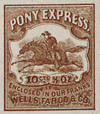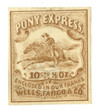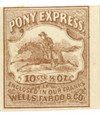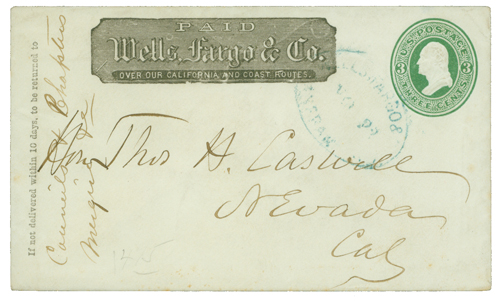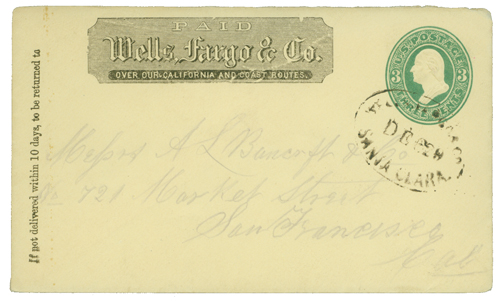
# 143L7 - 1862-64 10c Wells Fargo & Co. Local Stamp - Pony Express, brown
Own Scarce Pony Express Stamps
Few stamps match the Pony Express issues for romance and history – they’re genuine artifacts of the Wild West! Scarce in any condition, Pony Express stamps are even more difficult to find in multiples or with premium centering. Lock these gems into your private stamp collection.
The Virginia City Pony Express
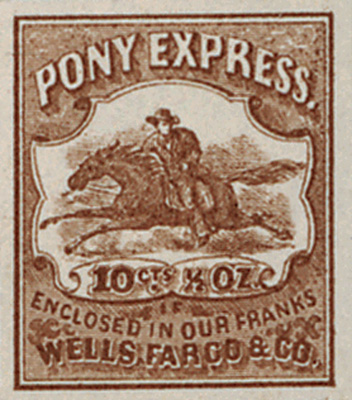
On August 11, 1862, Wells Fargo inaugurated its Virginia City Pony Express, which carried mail between Nevada mining towns and California business centers.
When California’s gold rush began in 1848, Vermonter Henry Wells and New York-native William Fargo, both partners in different express companies, realized the opportunities available to them in the West. In 1850, these two joined forces with John Warren Butterfield to establish the American Express Company (the same one now known for its credit card). When Wells and Fargo considered expanding to California, the company’s board declined. Instead, the two started their own business.
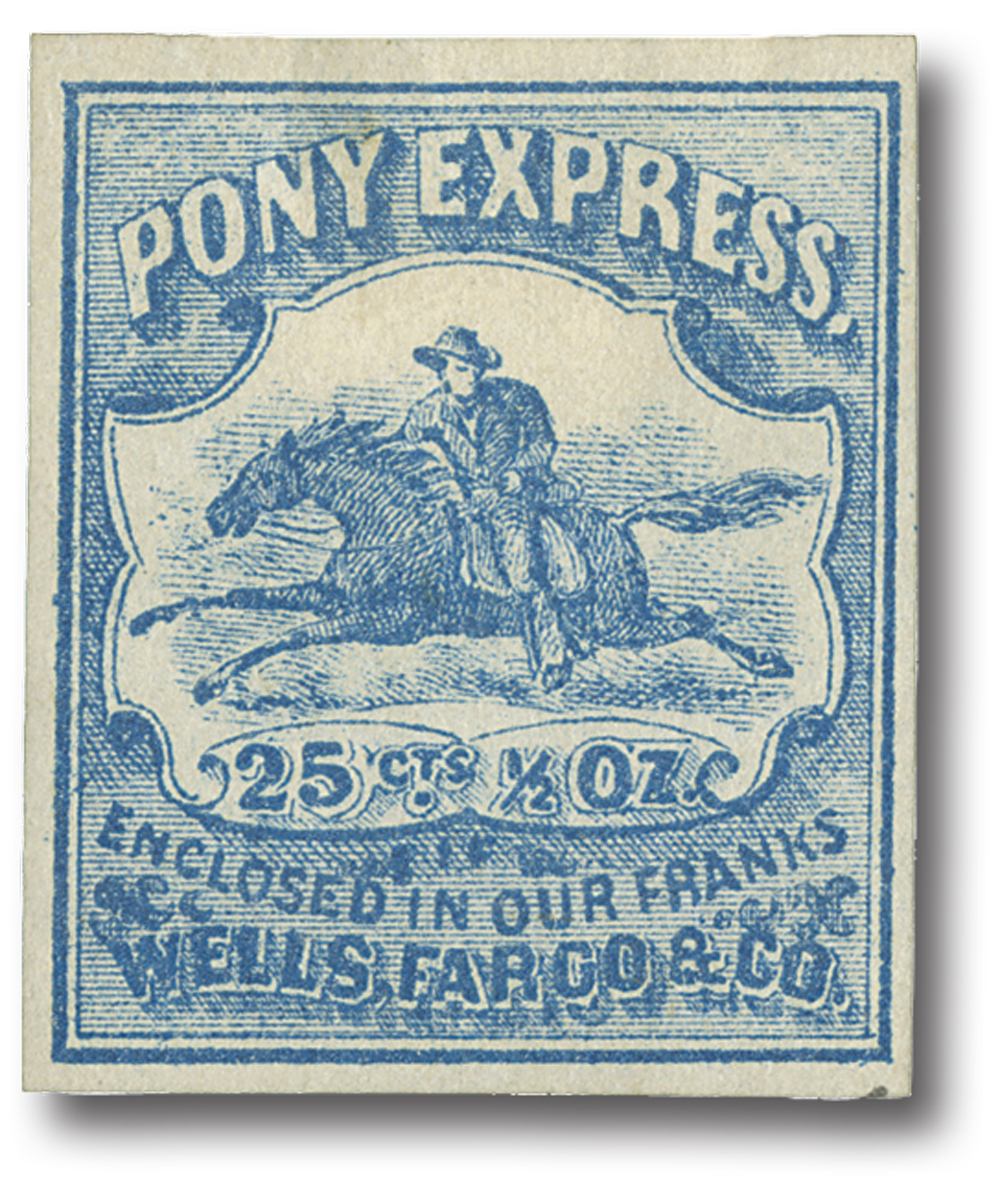
On March 18, 1852, Wells Fargo & Company was organized to provide express and banking services to California. Business started on May 20, 1852. At the time, California didn’t regulate the banking or express industry. Wells Fargo offered freight service between NY and California. They quickly opened offices in key communities bordering gold fields along with a network of freight and messenger routes throughout California.
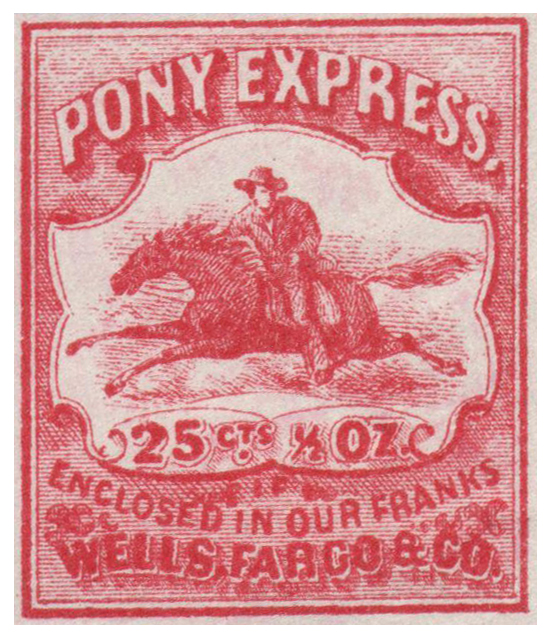
In the early days of the American West, the Post Office enjoyed a legal monopoly on mail service. All private carriers, including Wells Fargo, broke the law by delivering mail. Californians protested and Congress passed a law allowing the private delivery of mail if the Post Office was paid, even when the post office didn’t touch the mail. Wells Fargo bought Post Office envelopes by the thousands, printed their own distinct Wells Fargo frank on the front, and carried most of the mail in the West. Congress later nullified the act, legalizing private express.
Wells Fargo was one of the few companies to survive and thrive following the Panic of 1855. In 1857, the Overland Mail Company was organized in part by Wells Fargo. One year later, Overland Mail was awarded a government contract to carry US mail over the southern overland route from St. Louis to California. Wells Fargo was Overland Mail’s banker and primary lender.
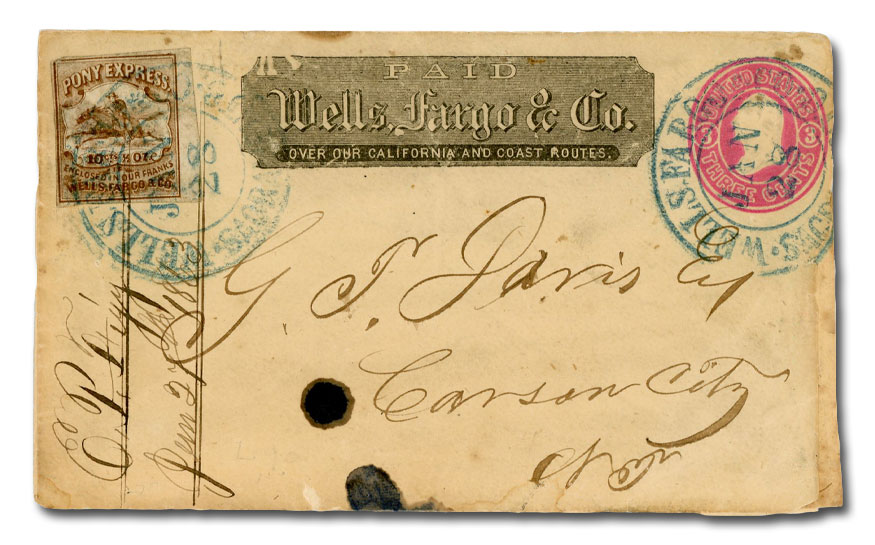
Before Wells Fargo began its own pony express service, the company ran stagecoaches to deliver letters and packages. They had previously operated part of the Pony Express and knew how effective that service had been. In 1862, with torrential rains making travel hard for stagecoaches going between Nevada Territory mining camps and the state of California, Wells Fargo organized a new “Pony.” Unlike the original Pony Express, this was a regional mail service called the Virginia City Pony Express.
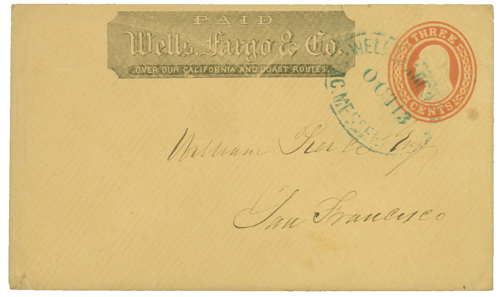
Ponies and riders could make the trip more easily and much faster than heavy stagecoaches over the rough and muddy terrain. The Virginia City Pony made its inaugural run on August 11, 1862. This service traveled between the Nevada mining towns of Carson City and Virginia City to the California business centers of Sacramento and San Francisco.
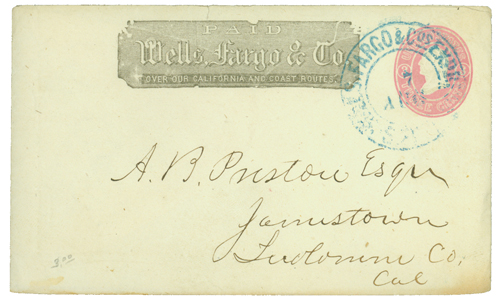
While the original Pony Express delivered news, the Virginia City Pony was more concerned with business matters. Letters required a 10¢ Pony Express stamp for every half-ounce, plus an appropriate US stamp to meet the current rate. The rate was raised to 25¢ in January 1863. By 1865, the roads were improved enough to allow for faster transportation and the Virginia City Pony was discontinued.
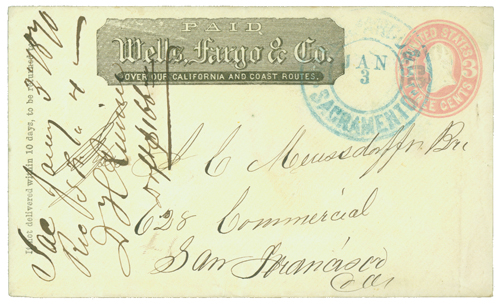
As for Wells Fargo, the completion of the Transcontinental Railroad brought about the end of long-distance stagecoach routes. The stagecoaches were then used to transport people and mail between small towns that lacked a railroad link. By the 1880s, the Post Office was able to offer better service at lower rates than Wells Fargo and they soon discontinued their mail service. Wells Fargo offered express service until 1918 when that service was taken over by the government. Since then, the company has focused on banking and financial services.
See more Wells Fargo covers below:
Own Scarce Pony Express Stamps
Few stamps match the Pony Express issues for romance and history – they’re genuine artifacts of the Wild West! Scarce in any condition, Pony Express stamps are even more difficult to find in multiples or with premium centering. Lock these gems into your private stamp collection.
The Virginia City Pony Express

On August 11, 1862, Wells Fargo inaugurated its Virginia City Pony Express, which carried mail between Nevada mining towns and California business centers.
When California’s gold rush began in 1848, Vermonter Henry Wells and New York-native William Fargo, both partners in different express companies, realized the opportunities available to them in the West. In 1850, these two joined forces with John Warren Butterfield to establish the American Express Company (the same one now known for its credit card). When Wells and Fargo considered expanding to California, the company’s board declined. Instead, the two started their own business.

On March 18, 1852, Wells Fargo & Company was organized to provide express and banking services to California. Business started on May 20, 1852. At the time, California didn’t regulate the banking or express industry. Wells Fargo offered freight service between NY and California. They quickly opened offices in key communities bordering gold fields along with a network of freight and messenger routes throughout California.

In the early days of the American West, the Post Office enjoyed a legal monopoly on mail service. All private carriers, including Wells Fargo, broke the law by delivering mail. Californians protested and Congress passed a law allowing the private delivery of mail if the Post Office was paid, even when the post office didn’t touch the mail. Wells Fargo bought Post Office envelopes by the thousands, printed their own distinct Wells Fargo frank on the front, and carried most of the mail in the West. Congress later nullified the act, legalizing private express.
Wells Fargo was one of the few companies to survive and thrive following the Panic of 1855. In 1857, the Overland Mail Company was organized in part by Wells Fargo. One year later, Overland Mail was awarded a government contract to carry US mail over the southern overland route from St. Louis to California. Wells Fargo was Overland Mail’s banker and primary lender.

Before Wells Fargo began its own pony express service, the company ran stagecoaches to deliver letters and packages. They had previously operated part of the Pony Express and knew how effective that service had been. In 1862, with torrential rains making travel hard for stagecoaches going between Nevada Territory mining camps and the state of California, Wells Fargo organized a new “Pony.” Unlike the original Pony Express, this was a regional mail service called the Virginia City Pony Express.

Ponies and riders could make the trip more easily and much faster than heavy stagecoaches over the rough and muddy terrain. The Virginia City Pony made its inaugural run on August 11, 1862. This service traveled between the Nevada mining towns of Carson City and Virginia City to the California business centers of Sacramento and San Francisco.

While the original Pony Express delivered news, the Virginia City Pony was more concerned with business matters. Letters required a 10¢ Pony Express stamp for every half-ounce, plus an appropriate US stamp to meet the current rate. The rate was raised to 25¢ in January 1863. By 1865, the roads were improved enough to allow for faster transportation and the Virginia City Pony was discontinued.

As for Wells Fargo, the completion of the Transcontinental Railroad brought about the end of long-distance stagecoach routes. The stagecoaches were then used to transport people and mail between small towns that lacked a railroad link. By the 1880s, the Post Office was able to offer better service at lower rates than Wells Fargo and they soon discontinued their mail service. Wells Fargo offered express service until 1918 when that service was taken over by the government. Since then, the company has focused on banking and financial services.
See more Wells Fargo covers below:



